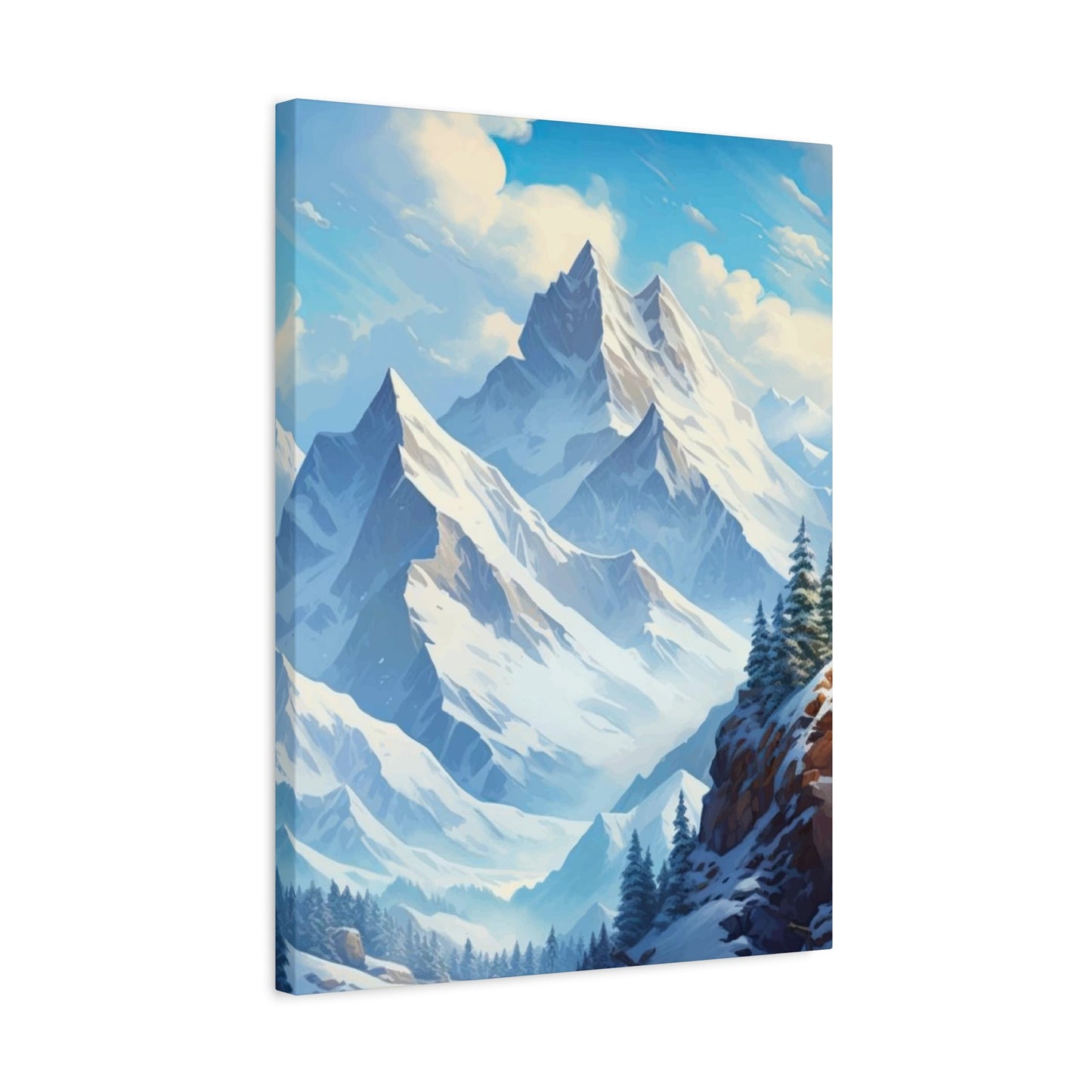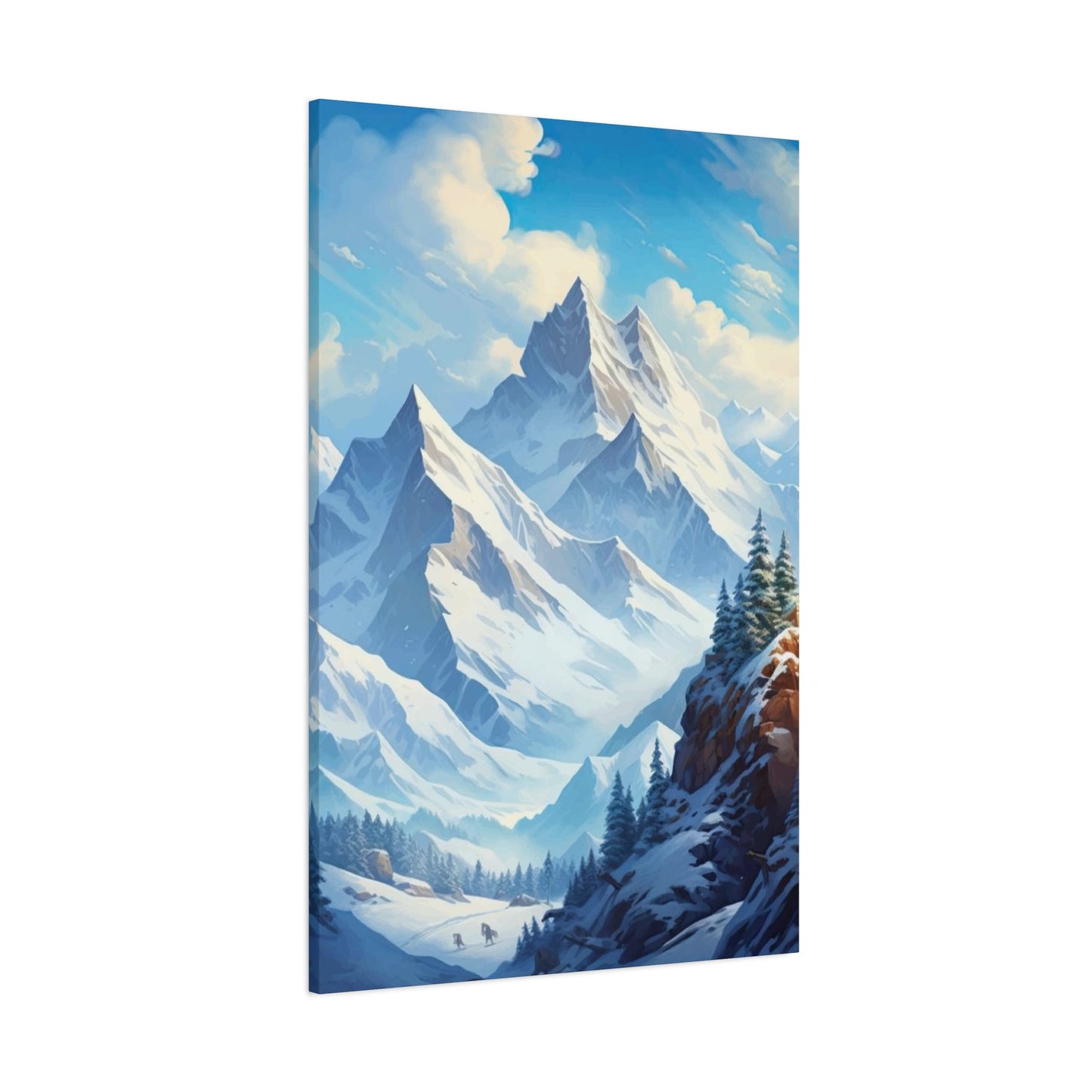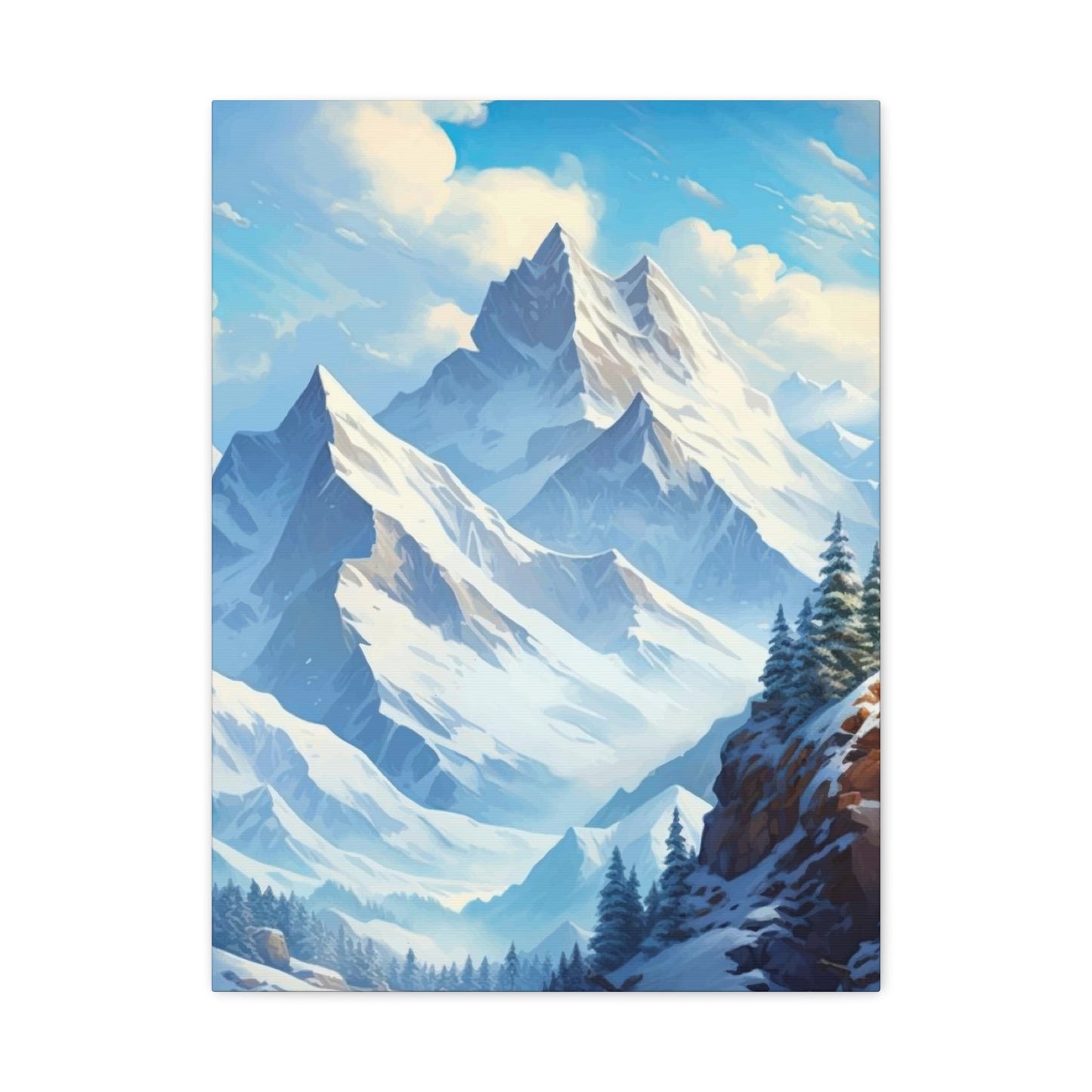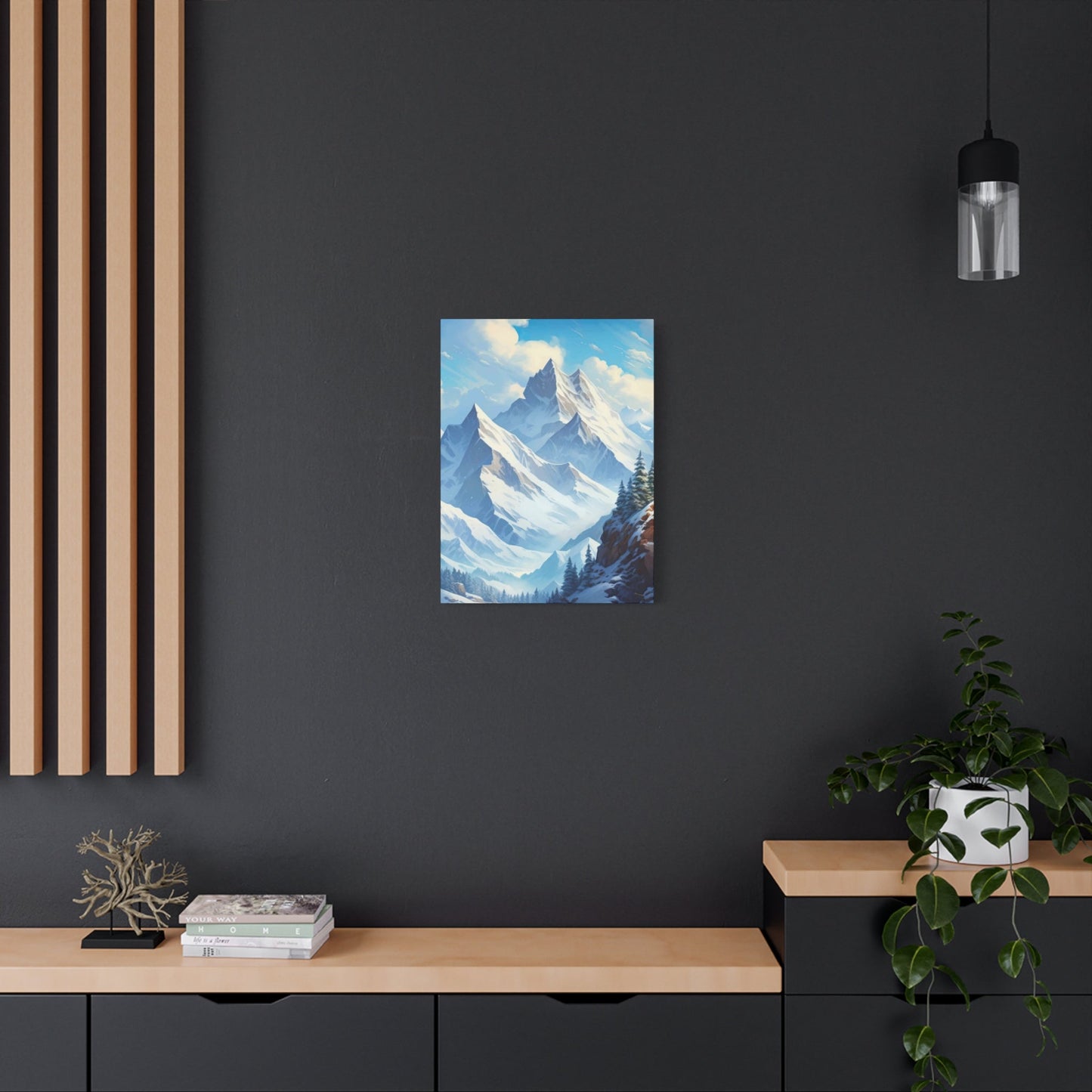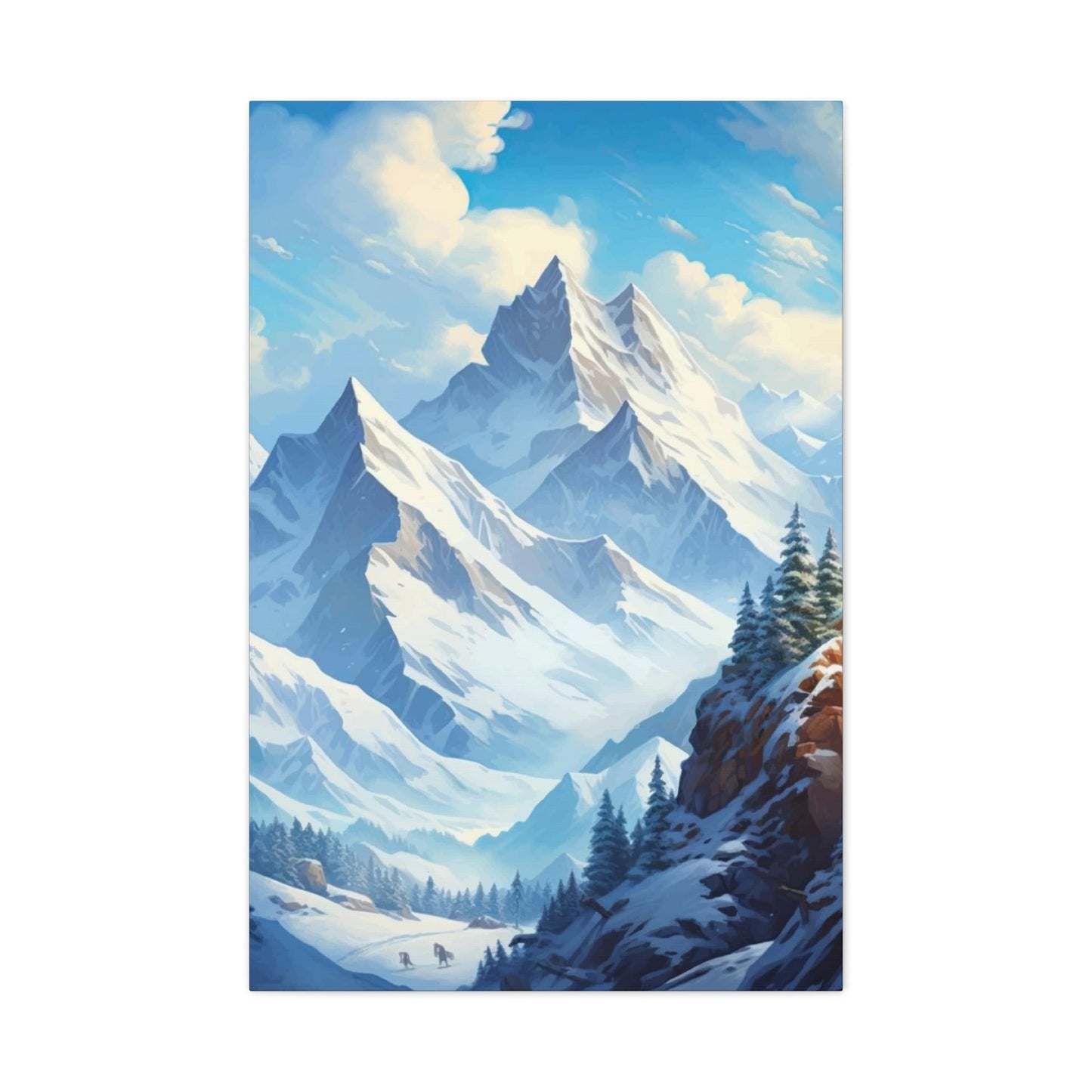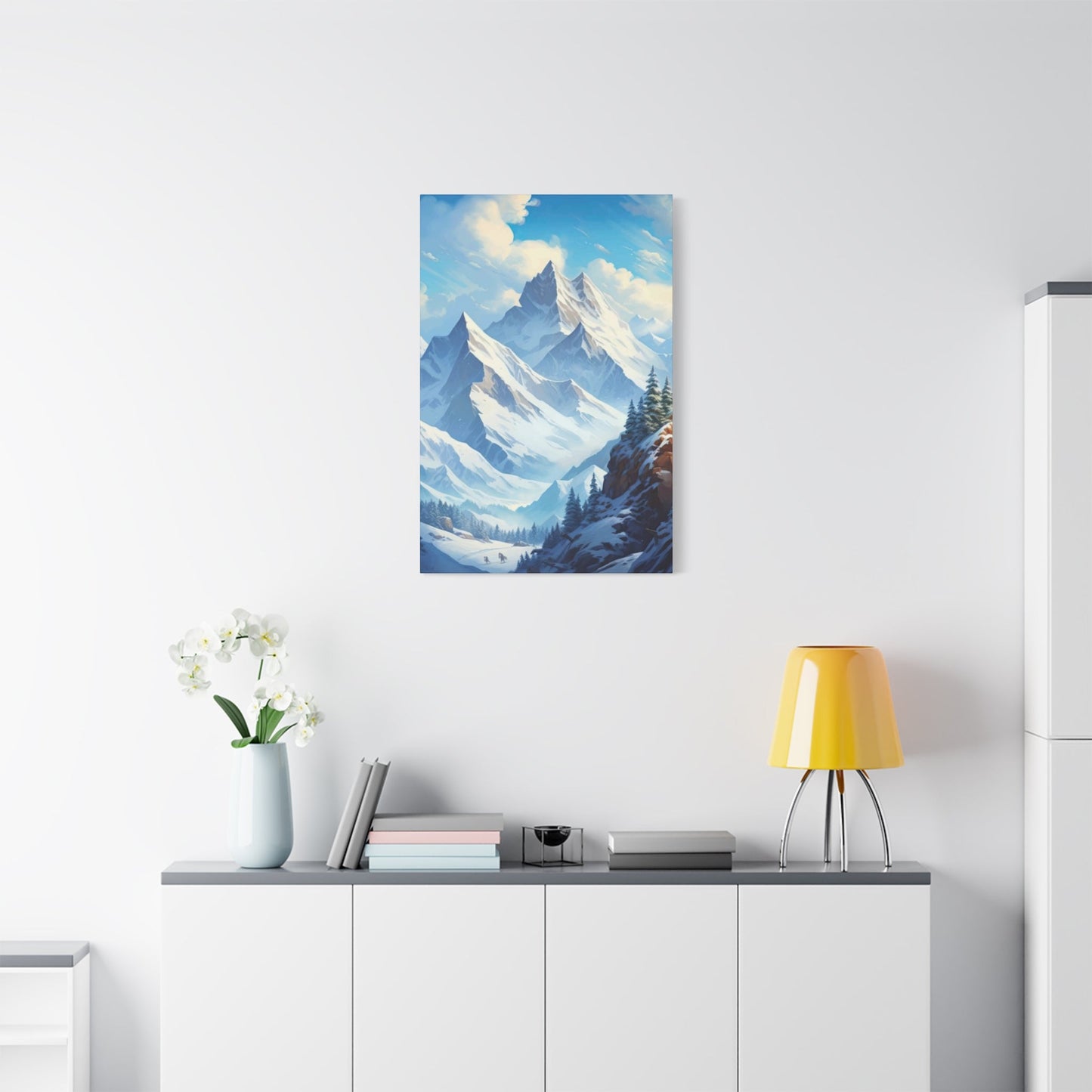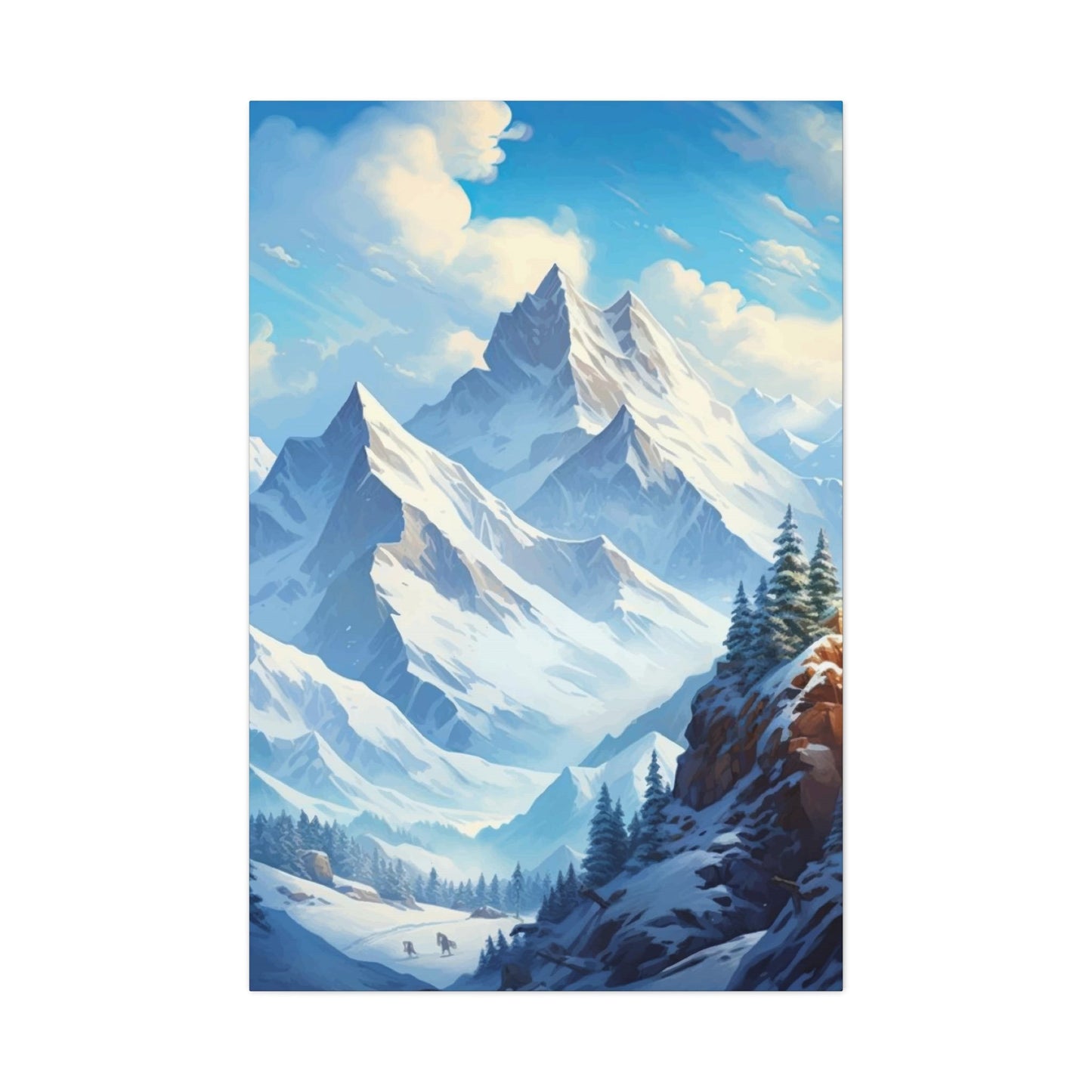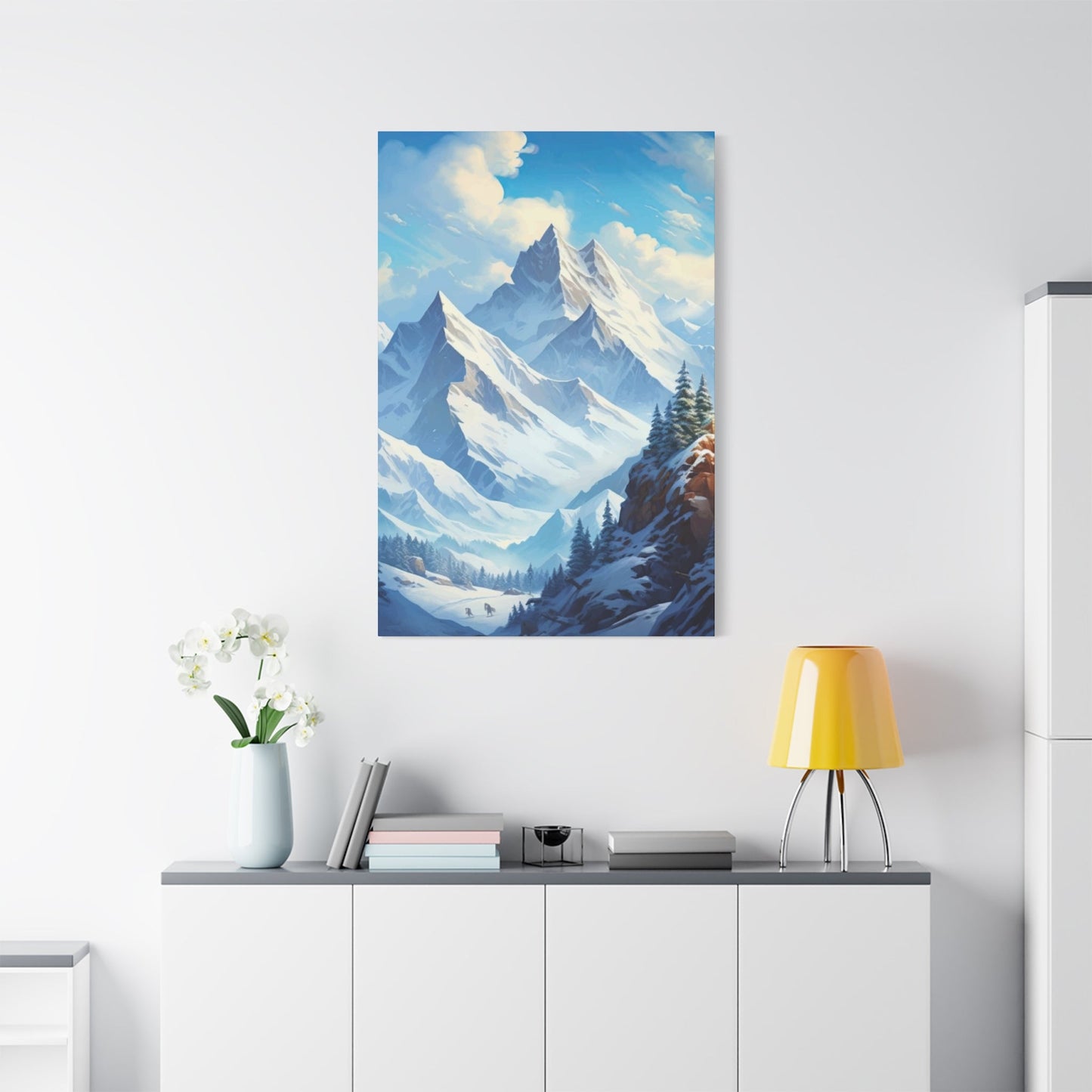The Ultimate Guide to White Mountains Canvas Wall Art: Transform Your Space with Alpine Elegance
Decorating your living or working space with artwork that captures the essence of nature brings a sense of calm and sophistication to any interior. Among the most sought-after themes in contemporary home décor are white mountains canvas prints that showcase the raw beauty of alpine landscapes. These stunning visual representations of snow-covered peaks and serene winter vistas have become increasingly popular for those seeking to create peaceful, inspiring environments. This comprehensive guide explores everything you need to know about incorporating majestic white mountains canvas art into your home, from understanding different styles to selecting the perfect piece for your unique space.
Understanding the Timeless Appeal of Snow-Capped Peaks Wall Art
The allure of mountain landscapes in visual art has captivated humanity for centuries, and modern canvas prints continue this tradition with enhanced accessibility and quality. Snow-capped peaks wall art represents more than just decorative elements; they embody the majesty of untouched wilderness and the peaceful solitude found in alpine environments. When you bring these images into your home, you create a connection to nature that can influence your mood, productivity, and overall sense of wellbeing.
Mountain imagery resonates deeply with people across cultures because it symbolizes strength, permanence, and natural beauty that transcends time. The white mountains depicted in these artworks often feature pristine snow covering rugged terrain, creating a visual contrast that draws the eye and calms the mind. Whether you prefer realistic photographic prints or more abstract interpretations, the fundamental appeal remains consistent: these pieces transport viewers to elevated places where air is crisp, views are endless, and worldly concerns feel distant.
Canvas prints offer particular advantages over other mediums for displaying mountain landscapes. The texture of canvas adds depth and dimensionality to images, making snow appear more luminous and peaks more tangible. Unlike paper prints behind glass, canvas creates a more organic, approachable aesthetic that complements both traditional and contemporary interior design schemes. The absence of glare allows you to appreciate the artwork from any angle, while the gallery-wrapped edges eliminate the need for traditional framing, creating a sleek, modern presentation.
The psychological benefits of displaying nature scenes in your environment are well-documented. Research in environmental psychology suggests that exposure to natural imagery can reduce stress, improve concentration, and enhance creative thinking. Mountain landscapes specifically evoke feelings of stability and perspective, reminding us of our place within the larger natural world. When you select tranquil mountain landscapes on canvas for your space, you're not merely choosing decoration but investing in your mental and emotional environment.
Exploring Different Styles of Serene White Mountains for Walls
The world of mountain canvas art encompasses a remarkable diversity of styles, each offering unique aesthetic qualities and emotional resonances. Understanding these different approaches helps you make informed decisions about which pieces will best complement your existing décor while expressing your personal taste.
Photographic realism represents one popular category, featuring high-resolution images of actual mountain ranges captured by skilled photographers. These prints preserve every detail of the landscape, from individual trees dotting snowy slopes to the subtle gradations of color in dawn or dusk skies. Photographic mountain art appeals to those who appreciate authenticity and want their walls to serve as windows to real places. The precision of these images can make viewers feel as though they could step directly into the scene, creating powerful immersive experiences.
Painterly styles offer a different approach, whether created through traditional artistic techniques or digital methods that simulate brushstrokes and texture. These interpretations of winter mountain scenes in art allow for more subjective expression, with artists emphasizing certain elements while softening others to create specific moods. Impressionistic mountain paintings might blur details to capture the essence of light playing across snow fields, while expressionistic versions might use bold colors and dramatic compositions to convey emotional responses to alpine environments.
Minimalist mountain art has gained tremendous popularity in recent years, particularly among those drawn to Scandinavian and contemporary design aesthetics. These pieces typically feature simplified forms, limited color palettes dominated by whites and grays, and clean compositions that emphasize geometric shapes within mountain silhouettes. The restraint of minimalist approaches creates a sense of zen-like calm, making these works ideal for meditation spaces, bedrooms, or any environment where tranquility is paramount. The simplicity also ensures these pieces remain versatile, complementing various interior styles without competing for visual attention.
Abstract interpretations take mountain themes in more conceptual directions, using the idea of peaks and snow as starting points for explorations of form, color, and texture. These works might deconstruct mountain imagery into geometric patterns, use unexpected color combinations to challenge conventional perceptions, or focus on particular aspects like the play of shadows on snow. Abstract mountain canvas prints appeal to collectors who appreciate artistic innovation and want conversation-starting pieces that invite multiple interpretations.
Selecting the Perfect Tranquil Mountain Landscapes on Canvas for Your Space
Choosing the right mountain canvas art for your space involves considering multiple factors beyond simply finding an image you like. The most successful art selections create harmony between the artwork, the room's architecture, existing furnishings, and the intended atmosphere of the space.
Scale represents one of the most critical considerations when selecting canvas prints. A common mistake is choosing artwork that's too small for the wall space, which can make the piece look insignificant and the room feel disjointed. As a general guideline, wall art should occupy approximately two-thirds to three-quarters of the width of the furniture piece it hangs above, such as a sofa or bed. For standalone walls, consider how the artwork relates to the overall wall dimensions. Large-scale mountain panoramas can serve as dramatic focal points in spacious rooms with high ceilings, while smaller prints work better in intimate spaces or as part of gallery wall arrangements.
Color coordination ensures your mountain canvas art enhances rather than clashes with your existing color scheme. While white mountains naturally feature predominantly cool tones, these pieces often include other colors in skies, foregrounds, or atmospheric effects. Consider the undertones in your room's palette when selecting artwork. If your space features warm neutrals like beiges and taupes, look for mountain prints with warmer elements such as golden-hour lighting or earthy foreground features. For rooms with cool gray or blue tones, pure white snow against steel-blue skies creates seamless integration.
The mood and energy level you want to establish in a space should influence your selection. For bedrooms and other relaxation areas, choose serene compositions with soft lighting and gentle slopes that promote calmness. Dynamic compositions featuring dramatic peaks, stormy skies, or intense contrasts work better in spaces meant for activity and energy, such as home offices or exercise areas. The movement within the composition, whether created by diagonal lines, suggested wind, or the viewer's eye path through the image, contributes significantly to the psychological impact of the piece.
Practical considerations like lighting and viewing distance also matter. Rooms with abundant natural light can accommodate darker, more dramatic mountain scenes without the space feeling heavy, while rooms with limited light benefit from brighter compositions featuring prominent white snow and light skies. Consider the primary viewing distance as well; artwork viewed from across large rooms can handle busier compositions and finer details, while pieces viewed up close in hallways or small rooms benefit from simpler, bolder compositions that remain effective at short distances.
The Artistic Process Behind Nature's Beauty Captured on Canvas
Understanding how mountain canvas prints are created helps you appreciate their value and make informed purchasing decisions. The journey from concept to finished product involves multiple stages, each contributing to the final artwork's quality and impact.
For photographic mountain prints, the process begins with photographers venturing into remote alpine environments, often enduring challenging conditions to capture perfect moments. These artists combine technical expertise with creative vision, understanding how camera settings, composition, and timing interact to produce compelling images. Many mountain photographers spend hours or even days waiting for ideal conditions, when clearing storms reveal fresh snow, when particular lighting angles illuminate peaks dramatically, or when atmospheric phenomena create unique visual effects.
Post-processing represents a crucial stage where photographers refine their captured images using sophisticated software. This step isn't about creating artificial scenes but rather about optimizing the image to convey the experience of being in that location. Adjustments to exposure, contrast, color balance, and sharpness ensure the printed image matches the photographer's vision and translates effectively to canvas. Skilled post-processing enhances the natural beauty already present while maintaining authenticity and avoiding over-manipulation that creates unrealistic results.
For painted or illustrated mountain art, artists begin with studies of actual mountain environments, developing understanding of how light interacts with snow, how geological formations create particular shapes, and how atmospheric perspective affects distant peaks. Even abstract or stylized interpretations typically root themselves in this foundational knowledge. Artists then execute their vision using various techniques, whether traditional paint application, digital painting with specialized software and tablets, or mixed media approaches combining multiple methods.
The actual printing process significantly impacts the final quality of canvas art. High-quality reproductions use giclée printing technology, which employs archival inks and high-resolution output to create prints that rival original paintings in detail and color accuracy. These inks resist fading for decades when properly displayed, ensuring your investment maintains its beauty over time. The canvas itself should be premium-grade, typically made from cotton or poly-cotton blends that provide appropriate texture and durability.
Gallery wrapping, where the canvas extends around wooden stretcher bars, creates the finished product's characteristic frameless appearance. Quality wrapping ensures even tension across the canvas surface, preventing sagging or warping over time. Some artists and printers include continuation of the image around the edges, while others use solid colors or mirrored edges. This detail matters particularly if you plan to display the canvas without additional framing.
Incorporating White Mountains Scenic Wall Prints into Various Interior Design Styles
Mountain canvas art's versatility allows it to enhance spaces decorated in numerous styles, from ultra-modern to traditionally rustic. Understanding how to integrate these pieces into different design contexts ensures they feel intentional rather than arbitrary.
In modern and contemporary spaces characterized by clean lines, neutral palettes, and uncluttered surfaces, minimalist mountain prints shine. Choose pieces with simplified compositions, limited color palettes, and strong geometric elements that echo the room's architectural features. Black and white mountain photography works exceptionally well in these settings, providing visual interest without introducing color that might conflict with the carefully curated palette. Consider large-scale single panels or triptychs with ample negative space that maintains the room's airy, uncluttered feeling.
Scandinavian or Nordic design, with its emphasis on natural materials, muted colors, and hygge coziness, provides ideal contexts for mountain artwork. These styles already draw inspiration from northern European landscapes, making alpine imagery a natural thematic fit. Pair white mountain prints with light wood furniture, soft textiles in cream and gray tones, and simple, functional accessories. The artwork reinforces the connection to nature central to Scandinavian design philosophy while adding visual focal points to otherwise understated spaces.
Traditional and transitional interiors benefit from mountain art that includes more classical composition techniques and richer color palettes. Look for pieces featuring warmer tones in skies or foregrounds, or opt for mountain scenes painted in more traditional artistic styles. These can complement wood furnishings, traditional textiles, and classic architectural details. Consider adding ornate frames to canvas prints in particularly formal traditional spaces, creating a bridge between the natural subject matter and the room's refined aesthetic.
Rustic and cabin-inspired spaces represent obvious contexts for mountain canvas art, but thoughtful selection prevents clichéd results. Rather than defaulting to typical lodge imagery, choose unexpected perspectives, seasons, or artistic interpretations. A minimalist white-on-white mountain print can provide striking contrast in a space otherwise filled with wood textures and traditional elements. Alternatively, dramatic black and white mountain photography adds sophistication to rustic settings, elevating them beyond typical cabin aesthetics.
Industrial and urban loft spaces, with their exposed brick, metal fixtures, and open floor plans, gain warmth and connection to nature through mountain artwork. The contrast between the built environment's hard edges and the organic forms of mountains creates compelling visual tension. Large-scale mountain prints can soften industrial elements while maintaining the dramatic scale these spaces demand. The cool tones common in mountain imagery complement industrial materials like concrete and steel without feeling decoratively incongruous.
Creating Impact with Peaceful Mountain Canvas for Interiors in Different Rooms
Each room in your home serves different functions and creates different experiences, making strategic artwork placement essential for maximizing both aesthetic and psychological benefits.
Living rooms, as primary gathering spaces, benefit tremendously from substantial mountain canvas art that serves as conversation starters and establishes the room's atmosphere. Position a large-scale mountain panorama above the main seating area, where it becomes a natural focal point without competing with television screens or fireplaces. The artwork should be at eye level when seated, typically positioning the center approximately 57 to 60 inches from the floor. In open-concept spaces, mountain art can help define the living area as distinct from adjacent dining or kitchen zones while maintaining visual flow through consistent color palettes or themes.
Bedrooms require particularly thoughtful art selection since the artwork significantly influences the space's restful qualities. Serene mountain landscapes with soft lighting, gentle slopes, and calming color palettes promote the relaxation necessary for quality sleep. Position artwork where you can see it from the bed but where it won't be the last thing your eyes focus on before sleep, as overly engaging images can make settling down difficult. Many people find that placing calming mountain scenes on walls opposite or perpendicular to the bed, rather than directly above the headboard, creates better energy for sleep.
Home offices and study spaces benefit from mountain artwork that inspires without distracting. Pieces featuring distant peaks and expansive views can provide visual breaks during intense focus periods, allowing your eyes and mind to rest before returning to work. The sense of perspective offered by mountain vistas can help maintain emotional balance during stressful work situations. Positioning artwork at or slightly above monitor height encourages periodic breaks to look up and refocus your vision on distant points, which eye health specialists recommend for reducing digital eye strain.
Dining spaces become more inviting and conversation-friendly with mountain art that creates ambiance without overwhelming the social aspects of shared meals. Choose pieces that complement your dining furniture in scale and style, and consider how the artwork looks under both natural and artificial lighting since dining rooms are used across different times of day. Mountain scenes with warmer elements or more dynamic compositions can energize dining spaces, making them feel more social and engaged than bedroom alternatives.
Entryways and hallways benefit from mountain canvas art that creates strong first impressions or guides movement through transitional spaces. In entries, mountain artwork immediately communicates your aesthetic sensibilities and establishes the home's atmosphere. These spaces often have specific wall proportions that favor vertical or smaller-scale compositions. In hallways, consider creating gallery walls with multiple mountain prints in varying sizes, or use a series of similarly sized pieces to lead the eye through the space. The repetition of mountain themes with variations in season, time of day, or perspective creates cohesive visual narratives.
Understanding the Benefits of Snowy Mountain Landscapes on Canvas in Wellness-Focused Spaces
The intersection of art and wellness has gained increasing attention as people recognize the environment's profound impact on physical and mental health. Mountain canvas art plays a particularly valuable role in spaces dedicated to wellness practices.
Meditation and yoga spaces benefit immensely from mountain imagery that supports contemplative practices. The stillness and permanence suggested by mountain forms provide mental anchors during meditation, helping practitioners maintain focus when the mind wanders. White mountains against clear skies offer visual simplicity that doesn't overstimulate but provides enough interest to prevent the space from feeling sterile. The verticality of mountain peaks can also serve as visual metaphors for spiritual aspiration or personal growth that align with many contemplative traditions.
Therapy and counseling offices increasingly incorporate nature imagery, including mountain scenes, to create safe, calming environments where clients feel comfortable opening up. The neutrality of landscape subjects avoids the potential complications of more personal or controversial artwork while still providing visual interest. Mountains specifically can serve as metaphorical resources during therapeutic conversations, representing challenges to overcome, perspectives to gain, or stable foundations to build upon.
Healthcare and healing spaces, from hospitals to alternative medicine clinics, recognize that environment affects patient outcomes. Mountain canvas art in waiting rooms, patient rooms, and treatment areas can reduce anxiety, lower blood pressure, and improve patient satisfaction. The restorative effects of nature exposure, even through representation, help counteract the stress inherent in medical situations. Choosing mountain scenes with particular qualities, such as dawn light suggesting new beginnings or cleared storms implying moving past difficulties, adds subtle supportive messaging.
Home gyms and fitness areas gain motivational benefits from mountain imagery that subconsciously associates exercise with outdoor adventure and the strength required for mountain pursuits. More dynamic mountain compositions with dramatic peaks or suggested movement through clouds or snow patterns can energize workout spaces. The presence of mountain art can also remind exercisers of broader fitness goals, such as preparing for hiking trips or connecting with nature, providing purpose beyond simple physical maintenance.
Bathrooms and spa-like spaces transform into personal retreats with the addition of mountain canvas art that enhances the restorative qualities of these rooms. The cool, clean tones of snowy mountain scenes complement bathroom fixtures and tile while creating associations with fresh mountain streams and pure alpine air. These connections elevate everyday routines like showering or bathing into more mindful, rejuvenating experiences. Consider moisture-resistant canvas treatments for bathroom artwork to ensure longevity in humid environments.
Mastering the Art of Displaying White Mountain Panoramas for Homes
The way you display canvas art significantly impacts its effectiveness and your space's overall aesthetics. Moving beyond simply hanging a single piece on a wall opens creative possibilities that can transform entire rooms.
Gallery walls featuring multiple mountain prints create dynamic, personalized displays that tell visual stories. When composing gallery walls, establish a unifying element such as consistent color palettes, similar frame styles, or thematic connections while varying sizes, orientations, and specific subjects. You might create a seasonal progression showing the same mountain range across different times of year, or gather mountain scenes from various locations you've visited. Plan your layout before putting holes in walls by arranging pieces on the floor or using paper templates taped to the wall to visualize the final composition.
Triptychs and multi-panel displays offer another approach, splitting a single mountain panorama across multiple canvases or presenting complementary scenes as a unified installation. These arrangements work particularly well above long furniture pieces like sofas or console tables, where their extended horizontal format matches the furniture's proportions. The space between panels, typically two to three inches, creates subtle rhythm while maintaining visual unity. Multi-panel displays also offer flexibility; you can adjust spacing or even separate panels into different rooms if your design needs change.
Leaning rather than hanging canvas art has become increasingly popular in contemporary and bohemian-style interiors. Large canvas prints can lean against walls on mantels, console tables, or even directly on floors, creating casual, easily changeable displays. This approach works particularly well with oversized mountain panoramas that make more impact as floor-leaning statements than as traditionally hung pieces. Layering multiple pieces of varying sizes while leaning creates depth and casual sophistication, though ensure proper support to prevent pieces from sliding or falling.
Corner installations use often-neglected spaces effectively while creating interesting angular viewing experiences. Positioning mountain canvas art to wrap around corners draws attention to architectural features and creates seamless visual flow between walls. This approach works especially well with complementary mountain scenes that share palettes or times of day but show different perspectives, suggesting the viewer is looking around a panoramic landscape.
Shelf and ledge displays combine artwork with three-dimensional objects, creating curated vignettes that add personality and depth to mountain canvas presentations. Picture ledges allow you to easily swap artwork and adjust arrangements without new nail holes, making them ideal for people who enjoy regularly refreshing their décor. Combine mountain prints with natural objects like stones, wood pieces, or plants to reinforce nature themes, or contrast with modern objects for eclectic sophistication.
Caring for and Preserving Your Calm and Scenic Wall Décor Investment
Proper care ensures your mountain canvas art maintains its beauty and value for years or even decades. Understanding best practices for maintenance, display conditions, and handling protects your investment.
Optimal display conditions prevent the most common causes of artwork degradation. Direct sunlight represents the primary threat to canvas prints, causing colors to fade and canvas fibers to weaken over time. Position mountain art away from windows receiving strong direct light, or use window treatments to filter UV rays during peak sunlight hours. If you must display canvas art in sunny locations, consider UV-protective treatments applied to the canvas or window films that block harmful rays while maintaining visibility.
Temperature and humidity fluctuations also affect canvas longevity. Extreme dryness can cause canvas to become brittle and crack, while excessive humidity promotes mold growth and warping. Maintain relatively stable indoor conditions, ideally between 65-75 degrees Fahrenheit with humidity levels around 40-50 percent. Avoid hanging canvas art directly above heating vents, radiators, or fireplaces where heat and air movement create particularly challenging conditions. Similarly, bathrooms and kitchens, despite being suitable locations aesthetically, require extra caution due to moisture and temperature variations.
Regular gentle cleaning keeps canvas art looking fresh without causing damage. Dust accumulation dulls colors and can work into canvas texture over time. Use a soft, dry microfiber cloth or a feather duster to gently remove surface dust every few months. For more thorough cleaning, very lightly dampen the cloth with water only, never using cleaning products or excessive moisture that can damage inks or canvas. Always test any cleaning approach on an inconspicuous edge area first. For valuable pieces or significant soiling, consult professional art conservators rather than attempting aggressive cleaning yourself.
Handling canvas art properly when moving or adjusting prevents accidental damage. Always lift canvas pieces from the sides of the stretcher frame, never pulling on the canvas surface itself. Avoid touching the printed surface with bare hands, as oils from skin can gradually affect inks. When transporting canvas art, protect it with clean cloth or bubble wrap, ensuring protective materials don't directly contact the printed surface. For long-term storage, wrap canvas pieces in acid-free paper and store flat or carefully upright in climate-controlled areas away from potential water damage.
Periodically inspect your mountain canvas art for early signs of problems. Look for fading, particularly in areas receiving indirect light exposure. Check for loose stretcher bars, sagging canvas, or separation between canvas and frame. Examine edges and backs for moisture damage, mold, or pest activity. Addressing small issues early prevents more serious deterioration. If you notice significant problems, consult art restoration professionals who can often repair damage before it becomes irreversible.
Investing in Quality: What Distinguishes Majestic Peaks Captured in Art
The market for mountain canvas art spans from inexpensive mass-produced prints to valuable limited editions and original works. Understanding quality markers helps you make purchases that provide appropriate value for your budget and needs.
Print quality fundamentals include resolution, color accuracy, and ink longevity. High-quality mountain prints use files with sufficient resolution to appear crisp at their intended display size, typically at least 300 DPI at full size. Lower resolution creates visible pixelation or softness that undermines the image's impact. Color accuracy ensures the print faithfully represents the artist's vision, requiring proper color management throughout the printing process. Archival inks, usually pigment-based rather than dye-based, resist fading for 100 years or more under proper conditions, while lower-quality dyes may noticeably fade within years.
Canvas material and construction affect both appearance and durability. Premium canvas typically uses cotton or cotton-poly blends with appropriate weight and texture. Very thin, lightweight canvas may be less expensive but is prone to sagging and shows stretcher bars through the print surface. Canvas should be taut across the stretcher frame without warping the frame or creating stress points that could lead to tearing. Gallery wrapping should show careful attention at corners, where proper folding technique creates neat, professional edges.
Stretcher frame quality is often overlooked but significantly impacts long-term satisfaction. Solid wood frames, preferably made from kiln-dried lumber, resist warping better than laminated or composite materials. Frames should include cross-bracing for prints larger than 20x24 inches, preventing sagging over time. Quality stretcher bars include beveled edges that angle away from the canvas, preventing the frame from creating visible lines on the print surface. Some premium options include adjustable corner keys that allow you to retighten canvas if minor sagging occurs.
Artist credentials and reputation matter when purchasing mountain photography or paintings. Established artists with strong portfolios, recognition in their fields, and proven track records of quality typically charge premium prices justified by their expertise and the superior results they consistently deliver. Research artists whose work you're considering, looking at their broader bodies of work, reading about their processes and philosophies, and verifying their credentials. Original works and limited editions from recognized artists often appreciate in value, making them genuine investments beyond mere decoration.
Editions and reproduction rights affect both price and exclusivity. Open edition prints can be reproduced indefinitely, making them more affordable but less exclusive. Limited editions restrict the total number of prints produced, with each numbered and often signed by the artist. Lower edition numbers and smaller total editions command higher prices due to greater exclusivity. Some artists also produce artist proofs, typically numbered with AP designations, which were historically used for quality checking but now represent another collectible category. Ensure any limited edition purchase includes proper documentation of the edition number and artist signature.
Discovering the Perfect Mountain Serenity Canvas Prints for Your Budget
Mountain canvas art is available across a wide price spectrum, making it accessible regardless of budget while also offering investment-grade options for serious collectors. Understanding what to expect at different price points helps you maximize value.
Entry-level options, typically under one hundred dollars, include small to medium-sized mass-produced prints on standard canvas. At this price point, expect decent quality suitable for temporary or less prominent display locations. These pieces work well for renters who plan to move, first apartments, or spaces where artwork might face higher risk of damage. While not heirloom quality, budget-friendly mountain prints can still effectively enhance your space if you shop carefully from reputable sellers who use quality printing processes and materials.
Mid-range selections, roughly between one hundred and five hundred dollars, represent sweet spots for many buyers, offering significantly improved quality without extreme cost. This range typically includes larger sizes, better canvas and stretcher frame materials, superior print quality with archival inks, and often works from emerging artists or stock images from established photographers. These pieces suit permanent living situations where you're investing in longer-term décor. The improved quality becomes noticeable in print clarity, color vibrancy, and the substantial feeling of proper construction.
Premium options, from five hundred to several thousand dollars, encompass larger formats, works from established artists, small limited editions, and pieces with exceptional production quality. At this level, you're purchasing museum-quality printing, premium canvas materials, expert mounting and finishing, and often supporting recognized artistic talent. These pieces serve as room focal points and potential long-term investments. Buyers in this range typically prioritize specific artistic visions, limited availability, or particular subjects like famous mountain ranges or unique perspectives.
Investment-grade mountain art, exceeding several thousand dollars, includes original paintings, highly limited photography editions from renowned artists, and works with significant provenance or historical importance. These pieces require careful consideration, often involving consultation with art advisors and including formal appraisals. Investment-grade art demands appropriate insurance coverage and professional handling for installation. While exceeding most decorative budgets, serious art collectors appreciate that exceptional works from recognized artists can appreciate significantly over decades.
Maximizing value regardless of budget involves researching thoroughly before purchasing. Compare similar pieces across multiple sellers to understand current market rates. Read reviews of both specific products and sellers to identify consistent quality issues or particularly reliable sources. Consider total costs including shipping, which can be substantial for large canvas pieces requiring special handling. Watch for sales and promotions, particularly during major shopping events, but verify that discounted pieces still meet quality standards. Finally, prioritize pieces you genuinely love; artwork you connect with provides value beyond any price tag through the daily enjoyment it brings.
Exploring the Emotional and Psychological Impact of Snowy Horizons Wall Art
The artwork we surround ourselves with significantly influences our emotional states and psychological wellbeing. Mountain canvas art produces specific effects worth understanding as you curate your environment.
Stress reduction represents one of the most researched benefits of nature imagery. Studies consistently show that viewing natural scenes, including mountains, lowers cortisol levels, reduces heart rate, and decreases blood pressure. The mechanisms behind these effects include both learned associations between nature and relaxation and evolutionary predispositions toward environments suggesting safety and resources. Mountain scenes specifically provide visual complexity that engages attention without overwhelming, creating a form of gentle mental engagement that allows stress-response systems to deactivate.
Attention restoration theory explains how nature exposure combats mental fatigue caused by sustained directed attention required by modern life. Natural environments and their representations allow what researchers call soft fascination, where our attention is gently engaged without effort, allowing cognitive resources to replenish. Mountain landscapes offer particularly effective restoration because they provide visual interest across multiple depth planes, from foreground details through middle ground features to distant peaks, encouraging the type of gentle visual exploration that facilitates mental rest.
Emotional regulation benefits from the presence of natural imagery that can serve as visual anchors during difficult emotional states. When feeling overwhelmed, anxious, or sad, shifting focus to calming mountain scenes interrupts rumination patterns and provides alternative focal points for attention. The stability and permanence suggested by mountain forms offer psychological anchoring that contrasts with emotional turbulence. Over time, repeatedly using artwork this way creates classical conditioning associations where simply viewing the piece triggers relaxation responses.
Inspiration and motivation find support in mountain imagery through both symbolic and aesthetic channels. Mountains universally symbolize challenges to overcome, heights to reach, and perspectives to gain, making them powerful metaphorical resources. The achievement implied in reaching mountain summits translates psychologically to other goals and challenges. Aesthetically, the grandeur and beauty of mountain landscapes can evoke awe, an emotion increasingly recognized for its psychological benefits including increased life satisfaction, greater generosity, and expanded sense of time availability.
Seasonal affective responses, where limited daylight during winter months creates mood problems for susceptible individuals, may be partially addressed through mountain art featuring bright snow reflecting light. While not replacing proven treatments like light therapy, bright white mountain scenes can contribute to creating lighter, more cheerful environments during darker months. The association between snow and the winter season is reframed from darkness and cold to brightness and pristine beauty, potentially shifting emotional responses to winter.
Creating Cohesive Design with Tranquil Nature Scenes for Interiors Throughout Your Home
Rather than treating artwork as isolated decorative elements, creating thematic or stylistic connections between pieces throughout your home produces sophisticated, intentional design narratives that elevate the entire space.
Thematic consistency through mountain imagery creates clear aesthetic identity while allowing for variation that prevents monotony. You might establish a mountain theme throughout your home but vary the artistic style, scale, or specific mountain ranges depicted in different rooms. This approach creates visual dialogue between spaces while respecting their individual functions and characters. Living areas might feature dramatic wide-angle panoramas while bedrooms display intimate close-ups of snow-covered branches, all united by the overarching theme.
Color palette coordination ensures mountain art in different rooms works together even when pieces differ significantly in subject or style. Extract key colors from one significant piece and use those as guides for selections elsewhere. If your primary living room mountain print features distinctive blue-gray tones in evening light, choosing other pieces with similar undertones creates subtle connection. This doesn't mean everything must match precisely, but conscious awareness of color relationships prevents jarring transitions as you move through spaces.
Progressions and narratives can be created by deliberately sequencing artwork to tell stories or suggest journeys. An entryway might feature a distant mountain view, with pieces in subsequent spaces moving progressively closer to the peaks, culminating in a detailed summit view in a personal space like a home office or bedroom. Alternatively, create seasonal progressions showing the same mountains across different times of year as you move through rooms, or a time-of-day sequence from dawn to dusk.
Scale relationships between artwork in adjacent or visually connected spaces require consideration in open-concept homes where multiple rooms are simultaneously visible. Dramatic scale shifts can feel jarring, while too much similarity becomes monotonous. Generally, vary sizes while maintaining some proportional relationship. If your living room features a massive mountain panorama, don't position a tiny print in the immediately adjacent dining area. Instead, choose something moderately sized that feels intentionally smaller rather than inadequately scaled.
Style mixing, when done thoughtfully, creates dynamic, collected-over-time aesthetics rather than matched-set predictability. You might combine a photographic mountain print in the living room with a more abstract interpretation in the dining area and a minimalist graphic representation in the bedroom. The key to successful mixing is maintaining some consistent elements, whether color palette, subject matter, or overall aesthetic mood, that create relationships between otherwise diverse pieces.
Seasonal Rotation and Refreshing Your White Mountains in Minimalist Art Display
While quality canvas art represents an investment you'll enjoy for years, strategic rotation and periodic refreshing prevent your décor from feeling stale while maximizing your art collection's value.
Seasonal rotations allow you to maintain mountain themes while adjusting for seasonal mood shifts. Display pieces featuring snow-covered peaks and winter scenes during colder months, then swap to mountain landscapes showing spring flowers, summer greenery, or autumn colors as seasons change. This practice keeps your environment feeling current and responsive to natural cycles. Store off-season pieces properly to maintain their condition, and use rotation opportunities to inspect and clean artwork.
Occasion-based displays let you emphasize different aspects of your collection for special events or personal milestones. When hosting gatherings, feature your most impressive conversation-starting mountain pieces. During periods requiring intense focus, rotate to your most calming, minimalist mountain prints. If preparing for a significant adventure or life change, display mountain art that symbolizes aspiration and challenge. This flexibility keeps your environment dynamically aligned with current life circumstances.
Gallery wall refreshes involve rearranging existing pieces into new configurations rather than acquiring new art. This approach works particularly well if you've assembled substantial collections over time. Experiment with different groupings, compositions, and relationships between pieces. What hung in your living room might create fresh impact in your bedroom with appropriate surrounding pieces. Photograph different arrangements before committing to help visualize options.
Strategic new additions to existing collections should complement and enhance what you already own rather than randomly accumulating pieces. Before purchasing new mountain art, consider how it will relate to your current collection. Does it fill a gap in style, color, or subject matter? Does it provide desired contrast or similarity? Thoughtful collecting builds cohesive assemblages greater than the sum of individual pieces.
Trading or lending arrangements with friends who share your appreciation for mountain art provides free variety. If you have trusted friends with compatible tastes, consider borrowing pieces from each other's collections periodically. This arrangement lets everyone enjoy greater variety while building community around shared interests. Establish clear terms about care responsibility, duration, and insurance considerations to prevent misunderstandings.
Commissioning and Customizing Scenic Canvas Prints for Modern Homes
For those seeking truly personalized mountain art, commissioning custom pieces or customizing existing images creates one-of-a-kind installations perfectly suited to your space and vision.Working with photographers to create custom prints of specific mountain ranges or locations holds particular appeal for people with meaningful connections to certain places. Perhaps you got engaged on a particular mountain, grew up with a specific range visible from your childhood home, or completed a meaningful journey to a remote peak. Commissioning a photographer to capture that location, or licensing an existing image for a custom-sized print, creates deeply personal artwork. Discuss your vision, preferred perspectives, lighting, and seasons with photographers, who can advise on what's feasible and when conditions are optimal for capturing the desired image.
Collaborating with digital artists allows for creative reinterpretations of mountain imagery tailored to your aesthetic preferences. These artists can create original works inspired by specific mountains but rendered in particular styles, color palettes, or compositional approaches. You might request a mountain scene in the style of a favorite artistic movement, using colors that perfectly match your interior design, or incorporating symbolic elements meaningful to you. Digital creation allows for iteration and revision before final printing, ensuring complete satisfaction.Customizing existing artwork through cropping, color adjustment, or format changes adapts available images to your specific needs. Many print services offer customization options that let you adjust pre-existing mountain photographs or illustrations. Crop images to emphasize particular compositional elements or to fit unusual wall dimensions. Adjust colors to shift cooler images warmer or vice versa.
Final Thoughts:
White mountains canvas wall art offers a unique way to bring the serene majesty of alpine landscapes into your living space. Whether you’re drawn to the crisp snow-capped peaks, the tranquil forests, or the ethereal mist rolling over mountain ridges, this style of art provides a timeless connection to nature’s grandeur. Reflecting on the role white mountains art plays in home decor reveals why it remains a favorite choice for those seeking to infuse their spaces with elegance, calm, and inspiration.
One of the greatest strengths of white mountains canvas art lies in its ability to evoke a sense of peace and awe simultaneously. Mountains have long symbolized strength, stability, and endurance, while their snowy peaks conjure images of purity and renewal. This combination makes mountain art particularly powerful for creating environments that promote relaxation and mindfulness. Whether displayed in a living room, bedroom, or office, these canvases offer visual respite from the demands of daily life, inviting viewers to pause and reconnect with nature’s enduring beauty.
The color palette typical of white mountains art — dominated by whites, cool blues, and soft greys — brings a refreshing clarity to any room. These tones work wonderfully to brighten spaces and complement a variety of decor styles. From minimalist modern interiors that emphasize clean lines and neutral shades, to rustic or Scandinavian designs that celebrate natural materials and textures, alpine-themed canvas art integrates seamlessly. Its subtle hues provide a soothing backdrop that enhances both light and space, making rooms feel more open and airy.
Versatility is another key benefit of incorporating white mountains canvas wall art. The range of available styles — from hyper-realistic photographic prints to impressionistic brushstrokes or abstract interpretations — means there’s something to suit every taste. Large statement pieces can serve as focal points that anchor the room, while smaller canvases can be grouped in galleries or used as complementary accents. This flexibility allows homeowners to personalize their decor while maintaining the cohesive theme of alpine elegance.
Sustainability and a mindful approach to art collection are becoming increasingly important, and mountain-themed canvas art can align well with these values. Many artists and printmakers now use eco-friendly inks and sustainably sourced materials to produce high-quality canvases. Choosing art that honors the environment not only enhances your home aesthetically but also reflects a broader commitment to preserving the natural landscapes that inspire it.
The emotional resonance of white mountains art adds another layer of depth to its appeal. For many, mountains represent adventure, challenge, and the thrill of exploration — qualities that can motivate and inspire. Displaying alpine scenes in your home serves as a daily reminder of resilience and the beauty found in nature’s grandeur. It encourages a mindset of perseverance and calm determination, enriching both personal and professional spaces.
When planning to incorporate white mountains canvas art into your decor, consider how it interacts with your existing furnishings and color schemes. Complementary textures like natural wood, stone, and linen can amplify the organic feel of the artwork. Soft textiles such as wool throws or plush rugs create cozy contrasts to the crisp imagery, inviting tactile warmth. Lighting also plays a critical role — natural light enhances the luminosity of snowy peaks, while well-placed accent lighting can highlight details and add depth during evening hours.
The adaptability of alpine art across seasons makes it an especially practical decor choice. Unlike seasonal decor that requires frequent updating, white mountains canvas art maintains relevance year-round. Its cool palette is refreshing in summer months and perfectly aligned with winter themes, ensuring your space always feels thoughtfully curated and connected to nature’s rhythms.
Ultimately, white mountains canvas wall art is much more than a decorative element — it is an invitation to bring the tranquility, strength, and majesty of the alpine world into your everyday environment. It serves as a visual sanctuary where moments of calm and inspiration can be found amid the hustle and bustle of modern life.
In conclusion, transforming your space with white mountains canvas wall art is a timeless way to evoke alpine elegance and natural beauty. Whether you choose a dramatic panoramic view or a subtle, impressionistic scene, this art form enriches your home with serenity, style, and meaning. It connects you to the grandeur of the natural world while offering a canvas for reflection and rejuvenation.
As you explore options for integrating white mountains art into your home, remember that the key lies in choosing pieces that resonate with your personal vision and complement your lifestyle. By doing so, you create an environment that is both visually stunning and emotionally grounding — a true reflection of alpine elegance that transforms everyday living into an experience of natural grace.













